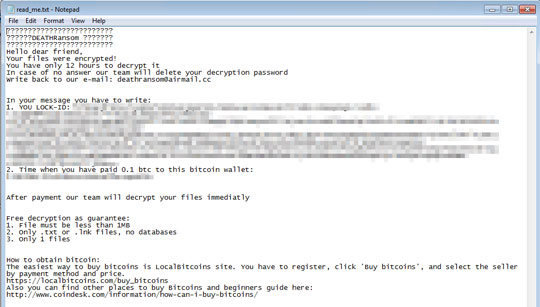Ransom.Win32.DEATHRANSOM.C
W32/Kryptik.ANT!tr (FORTINET); Trojan-FRON!C50AB1DF254C (NAI)
Windows


Threat Type: Ransomware
Destructiveness: No
Encrypted: Yes
In the wild: Yes
OVERVIEW
This Ransomware arrives on a system as a file dropped by other malware or as a file downloaded unknowingly by users when visiting malicious sites.
However, as of this writing, the said sites are inaccessible.
TECHNICAL DETAILS
Arrival Details
This Ransomware arrives on a system as a file dropped by other malware or as a file downloaded unknowingly by users when visiting malicious sites.
Other System Modifications
This Ransomware adds the following registry entries:
HKEY_CURRENT_USER\Software\Wacatac
public = {Hex characters}
HKEY_CURRENT_USER\Software\Wacatac
Private = {Hex characters}
It modifies the following registry entries:
HKEY_CURRENT_USER\Software\Microsoft\
Windows\CurrentVersion\Explorer\
CLSID\{645FF040-5081-101B-9F08-00AA002F954E}\DefaultIcon
"" = %System%\imageres.dll,-55
Dropping Routine
This Ransomware drops the following files:
- %System%\ntos.database
(Note: %System% is the Windows system folder, where it usually is C:\Windows\System32 on all Windows operating system versions.)
Download Routine
This Ransomware accesses the following websites to download files:
- https://{BLOCKED}er.org/1Zqq77
Other Details
This Ransomware does the following:
- It checks the machines default Language ID and keyboard layout, it will not perform its encryption routine if it matches the following:
- kk-KZ - Kazakhstan
- be-BY - Belarus
- uk- - Ukraine
- tt-RU/ru-RU - Russia
- It empties the recycle bin.
- It searches for files to encrypt in fixed drives, removable drives, and network resources.
However, as of this writing, the said sites are inaccessible.
Ransomware Routine
This Ransomware avoids encrypting files with the following strings in their file name:
- read_me.txt
- autoexec.bat
- desktop.ini
- autorun.inf
- ntuser.dat
- iconcache.db
- bootsect.bak
- boot.ini
- ntuser.dat.log
- thumbs.db
It avoids encrypting files with the following strings in their file path:
- programdata
- $recycle.bin
- program files
- windows
- all users
- appdata
It appends the following extension to the file name of the encrypted files:
- .{random extension}
It leaves text files that serve as ransom notes containing the following text:
- {Encrypted directory}\read_me.txt

SOLUTION
Step 1
Trend Micro Predictive Machine Learning detects and blocks malware at the first sign of its existence, before it executes on your system. When enabled, your Trend Micro product detects this malware under the following machine learning name:
- Troj.Win32.TRX.XXPE50FFF033
Step 2
Before doing any scans, Windows 7, Windows 8, Windows 8.1, and Windows 10 users must disable System Restore to allow full scanning of their computers.
Step 3
Note that not all files, folders, and registry keys and entries are installed on your computer during this malware's/spyware's/grayware's execution. This may be due to incomplete installation or other operating system conditions. If you do not find the same files/folders/registry information, please proceed to the next step.
Step 4
Identify and terminate files detected as Ransom.Win32.DEATHRANSOM.C
- Windows Task Manager may not display all running processes. In this case, please use a third-party process viewer, preferably Process Explorer, to terminate the malware/grayware/spyware file. You may download the said tool here.
- If the detected file is displayed in either Windows Task Manager or Process Explorer but you cannot delete it, restart your computer in safe mode. To do this, refer to this link for the complete steps.
- If the detected file is not displayed in either Windows Task Manager or Process Explorer, continue doing the next steps.
Step 5
Search and delete this file
- %System%\ntos.database
Step 6
Delete this registry value
Important: Editing the Windows Registry incorrectly can lead to irreversible system malfunction. Please do this step only if you know how or you can ask assistance from your system administrator. Else, check this Microsoft article first before modifying your computer's registry.
- In HKEY_CURRENT_USER\Software\Wacatac
- public = {Hex characters}
- public = {Hex characters}
- In HKEY_CURRENT_USER\Software\Wacatac
- Private = {Hex characters}
- Private = {Hex characters}
Step 7
Delete this registry key
Important: Editing the Windows Registry incorrectly can lead to irreversible system malfunction. Please do this step only if you know how or you can ask assistance from your system administrator. Else, check this Microsoft article first before modifying your computer's registry.
- In HKEY_CURRENT_USER\Software\Wacatac
Step 8
Scan your computer with your Trend Micro product to delete files detected as Ransom.Win32.DEATHRANSOM.C. If the detected files have already been cleaned, deleted, or quarantined by your Trend Micro product, no further step is required. You may opt to simply delete the quarantined files. Please check the following Trend Micro Support pages for more information:
Step 9
Restore encrypted files from backup.
Did this description help? Tell us how we did.

